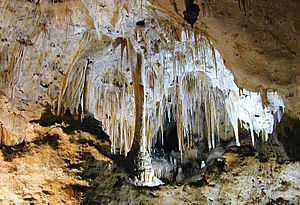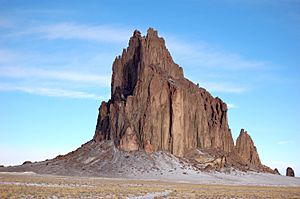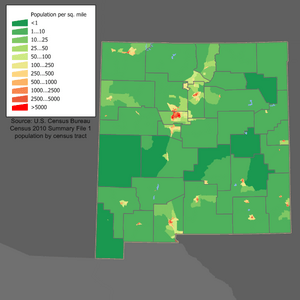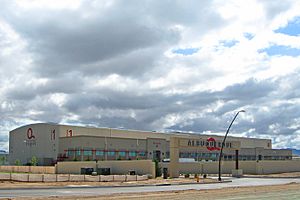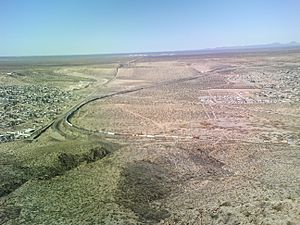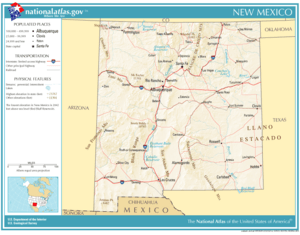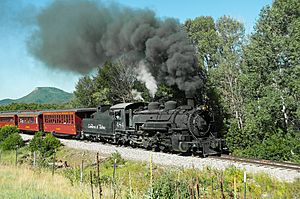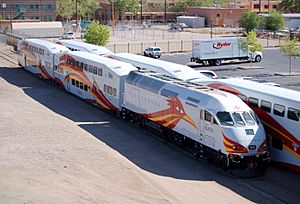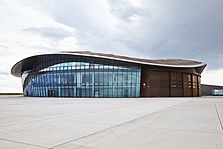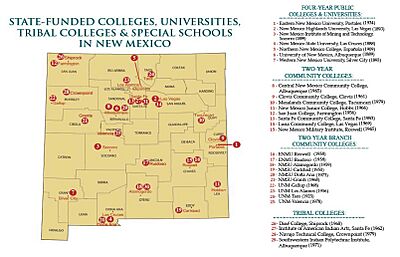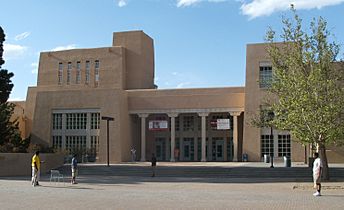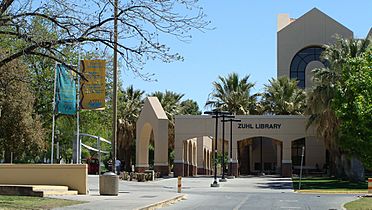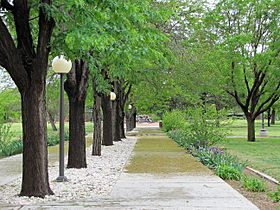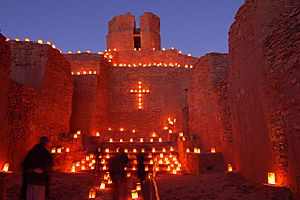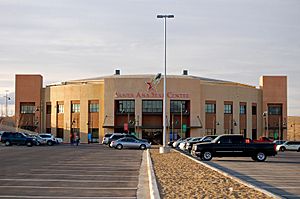New Mexico facts for kids
Quick facts for kids
New Mexico
|
|||
|---|---|---|---|
| State of New Mexico Estado de Nuevo México (Spanish) |
|||
|
|||
| Nickname(s):
The Land of Enchantment
|
|||
| Motto(s):
Crescit eundo (It grows as it goes)
|
|||
| Anthem: "O Fair New Mexico" and "Así Es Nuevo México" | |||
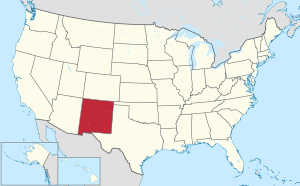
Location of New Mexico within the United States
|
|||
| Country | United States | ||
| Before statehood |
|
||
| Admitted to the Union | January 6, 1912 (47th) | ||
| Capital | Santa Fe | ||
| Largest city | Albuquerque | ||
| Largest county or equivalent | Bernalillo | ||
| Largest metro and urban areas | Albuquerque metropolitan area | ||
| Legislature | New Mexico Legislature | ||
| • Upper house | Senate | ||
| • Lower house | House of Representatives | ||
| Judiciary | New Mexico Supreme Court | ||
| U.S. senators |
|
||
| U.S. House delegation |
|
||
| Area | |||
| • Total | 121,591 sq mi (314,915 km2) | ||
| • Land | 121,298 sq mi (314,161 km2) | ||
| • Water | 292 sq mi (757 km2) 0.24% | ||
| Area rank | 5th | ||
| Dimensions | |||
| • Length | 371 mi (596 km) | ||
| • Width | 344 mi (552 km) | ||
| Elevation | 5,701 ft (1,741 m) | ||
| Highest elevation | 13,161 ft (4,011.4 m) | ||
| Lowest elevation
(Red Bluff Reservoir on Texas border)
|
2,845 ft (868 m) | ||
| Population
(2024)
|
|||
| • Total | |||
| • Rank | 36th | ||
| • Density | 17.2/sq mi (6.62/km2) | ||
| • Density rank | 45th | ||
| • Median household income | $62,300 (2023) | ||
| • Income rank | 45th | ||
| Demonym(s) | New Mexican (Spanish: Neomexicano, Neomejicano, Nuevo Mexicano) | ||
| Language | |||
| • Official language | None | ||
| • Spoken language | English, Spanish (New Mexican), Navajo, Keres, Zuni | ||
| Time zone | UTC−07:00 (Mountain) | ||
| • Summer (DST) | UTC−06:00 (MDT) | ||
| USPS abbreviation |
NM
|
||
| ISO 3166 code | US-NM | ||
| Traditional abbreviation | N.M., N.Mex. | ||
| Latitude | 31°20′ N to 37°N | ||
| Longitude | 103° W to 109°3′ W | ||
| Bird | Greater roadrunner |
|---|---|
| Fish | Rio Grande cutthroat trout |
| Flower | Yucca |
| Tree | Two-needle piñon |
| Insect | Tarantula Hawk Wasp |
New Mexico is a state in the Southwestern United States. It is known for its beautiful mountains and deserts. New Mexico is part of the Four Corners region, meeting Utah, Colorado, and Arizona. It also shares borders with Texas, Oklahoma, and the Mexican states of Chihuahua and Sonora.
Albuquerque is New Mexico's largest city. The state capital is Santa Fe, which was founded in 1610. Santa Fe is the oldest state capital in the U.S.
New Mexico is the fifth-largest state in size. However, it has a smaller population, ranking 36th among the 50 states. Its landscape is very diverse, from tall forests to dry deserts. The Rio Grande river flows through the state, creating a green valley. About one-third of New Mexico's land is owned by the U.S. government. It has many protected areas and national monuments. These include three UNESCO World Heritage Sites.
New Mexico's economy is varied. It includes ranching, farming, and technology. Mining, oil and gas, and film production are also big parts of its economy. The state has important U.S. military bases and research centers. These include Sandia National Laboratories and Los Alamos National Laboratory. The first atomic bomb was developed and tested in New Mexico.
In ancient times, New Mexico was home to Ancestral Puebloans and other Native American groups. Spanish explorers arrived in the 1500s. After Mexico became independent in 1821, New Mexico was part of Mexico. The U.S. took over New Mexico in 1848 after the Mexican–American War. It became the 47th U.S. state on January 6, 1912.
New Mexico's history has created its unique culture. It has the highest percentage of Hispanic and Latino Americans in the U.S. It also has the second-highest percentage of Native Americans. The state is home to many Navajo people, 19 Pueblo communities, and three Apache tribes. The flag of New Mexico shows the sun symbol of the Zia tribe. Its colors, red and gold, come from the Spanish flag. This mix of Native American, Spanish, and American influences can be seen in New Mexico's food, music, and buildings.
Understanding the Name of New Mexico
New Mexico got its name long before the country of Mexico became independent in 1821. The name "Mexico" comes from the Nahuatl language. It first referred to the homeland of the Mexica people, who ruled the Aztec Empire.
Spanish explorers came to this area in the 1500s. They called the region north of the Rio Grande Nuevo México. They hoped to find rich native cultures like the Mexica. The native groups in New Mexico were not related to the Mexica. They also did not have the same riches. But the name Nuevo México stuck.
Before New Mexico became a state in 1912, its borders changed many times. But the name "New Mexico" always referred to this general area.
New Mexico's Geography and Landscapes
New Mexico is the fifth-largest state in the U.S. It covers about 314,915 square kilometers (121,590 square miles). Its eastern border is with Oklahoma and Texas. To the south, it borders Chihuahua and Sonora in Mexico. Arizona is to the west, and Colorado is to the north. The four states of New Mexico, Colorado, Arizona, and Utah meet at the Four Corners.
New Mexico has many different landscapes. It has wide deserts, green grasslands, and high, snowy mountains. About one-third of the state is covered in forests. The Sangre de Cristo Mountains, part of the Rocky Mountains, are in the north. The Great Plains stretch into the eastern part of the state. The Chihuahuan Desert, North America's largest, covers the south.
Most of New Mexico is high above sea level. The average elevation is about 1,741 meters (5,701 feet). The highest point is Wheeler Peak at over 4,011 meters (13,160 feet). The lowest point is Red Bluff Reservoir at about 868 meters (2,840 feet).
Rivers and Lakes in New Mexico
The Rio Grande is a major river in New Mexico. It is one of the longest rivers in the U.S. Other important rivers are the Pecos, Canadian, San Juan, and Gila. The Rio Grande has been very important to the state's history. Its fertile valley has supported people for thousands of years.
Most major rivers in New Mexico have dams. These dams provide water for farming and help control floods. New Mexico has few large natural lakes. But it has several man-made lakes and reservoirs. The largest is Elephant Butte Reservoir. It was once the largest man-made lake in the world.
New Mexico's Climate
New Mexico is known for its dry, sunny weather. Most of the state has a semi-arid (somewhat dry) to arid (very dry) climate. Higher elevations have colder, alpine climates. The state gets about 34.8 centimeters (13.7 inches) of rain each year. More rain falls in the summer, especially in the north-central area.
Temperatures vary across the state. In the southeast, the average annual temperature can be 18°C (65°F). In the northern mountains, it can be below 4°C (40°F). Summer daytime temperatures can often go above 38°C (100°F) in lower areas. In winter, nighttime temperatures can drop below freezing.
New Mexico's clear skies and low population make it great for looking at stars. It is home to several major. These include the Very Large Array.
Plants and Animals of New Mexico
New Mexico's varied landscape supports many different plants and animals. It has six main plant zones. The Upper Sonoran Zone covers about three-fourths of the state. It has prairie grasses, small pine trees, and juniper bushes. The Chihuahuan Desert in the south has shrubby creosote plants.
The northern mountains have many types of trees. These include evergreen conifers, spruce-fir, and aspen forests. The southern parts of the Rio Grande and Pecos valleys have good land for grazing and farming.
New Mexico's diverse climate and plants support many animals. Black bears, bighorn sheep, bobcats, cougars, deer, and elk live in the mountains. Coyotes, jackrabbits, kangaroo rats, and pronghorn antelope live in less mountainous areas. The greater roadrunner, New Mexico's state bird, is common in the southeast. Endangered species include the Mexican gray wolf. Over 500 types of birds live in or migrate through New Mexico.
Protecting New Mexico's Nature
About one-third of New Mexico's land is owned by the U.S. government. This is about 31.4 million acres. More than half of this land is managed by the Bureau of Land Management. Another third is managed by the U.S. Forest Service.
New Mexico was important in the early 1900s conservation movement. The Gila Wilderness was named the world's first wilderness area in 1924. The state also has nine national monuments. These include El Morro National Monument, created in 1906.
- Carson National Forest
- Cibola National Forest
- Lincoln National Forest
- Santa Fe National Forest
- Gila National Forest
- Gila Wilderness
- Coronado National Forest (in Hidalgo County)
Areas managed by the National Park Service include:
- Aztec Ruins National Monument
- Bandelier National Monument
- Carlsbad Caverns National Park
- Chaco Culture National Historical Park
- El Malpais National Monument
- El Morro National Monument
- Gila Cliff Dwellings National Monument
- White Sands National Park
New Mexico's Population and Cities
New Mexico is one of the least densely populated states. It has about 7 people per square kilometer (17 people per square mile). The state has 33 counties and 106 cities, towns, and villages. Only two cities have over 100,000 residents: Albuquerque and Las Cruces.
Most people live in the north-central part of New Mexico, around Albuquerque. The Albuquerque metropolitan area has over 918,000 people. This is one-third of all New Mexicans. It is next to Santa Fe, the capital. The larger Albuquerque–Santa Fe–Las Vegas combined statistical area includes almost 60% of the state's population.
Another major population center is around Las Cruces in the south. This area has about 214,000 residents.
New Mexico has 23 tribal reservations recognized by the federal government. This includes part of the Navajo Nation. Most of these tribes are in the northwest.
Largest Cities in New Mexico
| City | County | Population |
|---|---|---|
| Albuquerque | Bernalillo | 558,545 |
| Las Cruces | Doña Ana | 101,712 |
| Rio Rancho | Sandoval / Bernalillo | 96,159 |
| Santa Fe | Santa Fe | 83,776 |
| Roswell | Chaves | 47,775 |
| Farmington | San Juan | 45,450 |
New Mexico's Government
New Mexico's government is set up like the U.S. federal government. It has three main parts: executive, legislative, and judicial. The Constitution of New Mexico was approved in 1911.
The executive branch is led by the governor. Other elected officials include the lieutenant governor and attorney general. New Mexico's governor has more power than governors in some other states. They can appoint many high-ranking officials.
The legislative branch is called the New Mexico Legislature. It has two parts: the House of Representatives and the Senate. House members serve two-year terms. Senate members serve four-year terms. New Mexico's lawmakers are unique because they are volunteers. They only receive a small payment when they are in session.
The judicial branch is led by the New Mexico Supreme Court. This is the state's highest court. It hears appeals from lower courts. There are five judges on the Supreme Court. They are elected every eight years.
People and Cultures of New Mexico
The 2020 census counted 2,117,522 people in New Mexico. This was a small increase from 2010. Over half of New Mexicans (51.4%) were born in the state. About 9.4% were born in other countries.
New Mexico has the highest percentage of Hispanic and Latino Americans in the U.S. They make up almost half of all residents (49.3%). This group includes descendants of Spanish settlers from the 1500s. It also includes recent immigrants from Latin America.
New Mexico has the fourth largest Native American community in the U.S. They make up about one-tenth of the population. This is the second largest percentage after Alaska. New Mexico is home to many different Native American groups.
Languages Spoken in New Mexico
New Mexico has many residents who speak more than one language. About 28.5% of people aged 5 and older speak Spanish at home. About 3.5% speak Navajo. Some Spanish speakers are descendants of early Spanish settlers.
Besides Navajo, other Native American languages are spoken in New Mexico. These include Mescalero Apache, Jicarilla Apache, Tewa, and Zuni.
Official Language Status
New Mexico's constitution does not name any language as "official." However, it required laws to be published in both English and Spanish for many years. The state legislature can still publish laws in both languages. Amendments to the state constitution must be on the ballot in both English and Spanish.
People in court can speak in English or Spanish. The state also supports bilingual education in schools. In 1989, New Mexico was the first state to adopt the English Plus resolution. This supports accepting non-English languages. In 2008, New Mexico was the first state to use a Navajo textbook in public schools.
Religion in New Mexico

Most people in New Mexico are Christian. About one-third are Roman Catholic, and one-third are Protestant. The Catholic Church has deep roots in New Mexico's history. The San Miguel Mission in Santa Fe was built in 1610. It is the oldest Christian church in the continental U.S.
About one-fifth of residents do not belong to any religion. New Mexico has also been a center for the New Age movement. This includes different types of alternative medicine and spiritual practices.
New Mexico has a unique mix of religious traditions. This includes Puebloan traditions and Hispano folk Catholicism. This mix is sometimes called "Pueblo Christianity." It includes customs like maintaining acequias (water ditches) and ceremonial dances.
New Mexico's Economy

New Mexico's economy relies on oil and gas, entertainment, and scientific research. Tourism and government spending are also very important. The state offers tax breaks to help businesses grow.
In 2021, New Mexico's economy produced over $95 billion in goods and services. The average income per person was about $45,800. This was one of the lowest in the country. New Mexico has struggled with poverty. Its poverty rate is about 18%, which is among the highest in the U.S.
New Mexico has been moving away from just mining and ranching. It now focuses more on services, manufacturing, and tourism. In 2021, a record 39.2 million tourists visited the state.
Oil and Gas Production
New Mexico is the second largest crude oil producer in the U.S. It is also the ninth largest natural gas producer. The Permian and San Juan Basins are partly in New Mexico. These areas have a lot of natural resources.
New Mexico gets money from selling federal land to oil and gas companies. The state has a high amount of federal land with oil and gas.
Arts and Entertainment in New Mexico
New Mexican art comes from the traditions of Native American and Hispanic peoples. Pueblo pottery, Navajo rugs, and Hispano religious art are famous worldwide. Georgia O'Keeffe helped bring attention to the art scene in Santa Fe. Today, Santa Fe has many art museums and galleries.
New Mexico offers money to film companies. This includes tax credits for spending in the state. In 2022, film and TV spending reached over $855 million. Netflix chose New Mexico for its first U.S. production hub in 2018. NBCUniversal also opened a studio in Albuquerque in 2021. Albuquerque is often named one of the best cities for filmmakers.
New Mexico also has a unique music style called New Mexico music. It mixes country, Western, and regional Mexican sounds.
Technology and Innovation
New Mexico is part of the Rio Grande Technology Corridor. This area has many science and technology centers. These include Sandia National Laboratories and Los Alamos National Laboratory. Companies like Intel and HP also have operations here. Universities like the University of New Mexico are also part of this network.
New Mexico has been a science and technology hub since the mid-1900s. Los Alamos was where the first atomic bomb was designed. Robert H. Goddard did early rocket tests in Roswell. Bill Gates and Paul Allen founded Microsoft in Albuquerque in 1975.
The state government wants to make New Mexico a center for tech startups. The bioscience sector has grown a lot. New Mexico is also working on quantum computing and clean energy technologies.
New Mexico's high altitude and clear skies are good for space activities. The "Space Triangle" between Roswell, Alamogordo, and Las Cruces has seen many rocket tests. New Mexico is sometimes called the birthplace of the U.S. space program. It is home to Spaceport America, the world's first commercial spaceport.
Farming and Food Production
New Mexico has a long history of farming and ranching. This is helped by its acequias, which are old irrigation systems. Farming adds $40 billion to New Mexico's economy. It employs almost 260,000 people.
New Mexico is the top producer of chile peppers in the U.S. It is second in pecans and fifth in onions. The state vegetables are New Mexico chile peppers and pinto beans. Chile peppers are the most famous crop.
Dairy is the state's largest farm product. Milk sales alone total $1.3 billion. New Mexico also has large ranches for cattle.
New Mexico is known for its unique food, called New Mexican cuisine. It blends Native American, Spanish, and Mexican flavors. Famous dishes include sopapillas, green chile stew, and carne adovada.
Tourism in New Mexico
New Mexico's unique culture, art, climate, and varied geography attract many tourists. In 2021, a record 39.2 million tourists visited the state.
New Mexico's food scene has become very popular. It has been featured on many TV shows. The state also offers many outdoor activities. These include hiking, skiing, hunting, and fishing.
The state government actively promotes tourism. It publishes New Mexico Magazine, which started in 1923.
Transportation in New Mexico
New Mexico has always been an important route for trade and travel. Ancient people built roads from Chaco Canyon. Later, the El Camino Real de Tierra Adentro was a key trade route for Spanish colonists.
The Santa Fe Trail was an important road in the 1800s. It connected New Mexico to the Eastern U.S. These old trails are now recognized as National Historic Trails. Railroads later replaced these trails. Today, New Mexico's Interstate Highways follow many of these old routes.
Road Travel
Most New Mexicans use cars to get around. The state has many miles of highways. There are three main Interstate Highways:
- Interstate 10 goes southwest from Arizona to Texas.
- Interstate 25 goes north-south from Las Cruces to Colorado.
- Interstate 40 goes east-west from Arizona to Texas.
In Albuquerque, I-25 and I-40 meet at a large interchange called The Big I.
New Mexico also has 15 United States Highways. The most famous was U.S. 66, known as the "Mother Road." It crossed northern New Mexico. Another famous route was US 666, called the "Devil's Highway." It was renamed U.S. Route 491 in 2003.
Train Travel
In 2000, New Mexico had about 3,788 kilometers (2,354 miles) of railroads. The first railway started in 1878. The Atchison, Topeka & Santa Fe Railway (ATSF) and the Southern Pacific Railroad created the nation's second transcontinental railroad in New Mexico.
The growth of railroads helped New Mexico's population and economy grow. The ATSF promoted tourism to the region. Famous trains like the Super Chief traveled through New Mexico.
Today, only Albuquerque and Santa Fe are connected by a rail network. The New Mexico Rail Runner Express is a commuter train. It connects Albuquerque with Santa Fe and other communities.
Amtrak's Southwest Chief train passes through daily. It stops in Gallup, Albuquerque, and Santa Fe. It connects to Los Angeles and Chicago. The Sunset Limited train also stops in Lordsburg and Deming three times a week.
New Mexico has two major freight railroads: the BNSF Railway and the Union Pacific Railroad.
Air and Space Travel
New Mexico has four main commercial airports. Albuquerque International Sunport is the state's largest airport. It serves millions of passengers each year. Most other airports are smaller. They are used for general aviation.
New Mexico relies on a federal program called Essential Air Service. This program helps keep flights going to smaller, isolated communities.
Spaceport America
New Mexico is home to Spaceport America. This is the world's first spaceport built just for commercial space travel. It is located near Truth or Consequences. Rocket launches began in 2007. The spaceport officially opened in 2011. Companies like Virgin Galactic use it.
Over 300 suborbital flights have launched from Spaceport America. In 2021, VSS Unity launched humans into space from here. This made New Mexico the third U.S. state to do so.
Education in New Mexico
The New Mexico Public Education Department oversees schools in the state. New Mexico has a high number of people with PhDs. This is partly because of its many federally funded research centers. However, New Mexico often ranks low in studies about school quality.
In 2018, a judge ruled that New Mexico was not providing enough education for at-risk students. These include Native American, non-English-speaking, and low-income students. The state has since tried to improve education. It increased teacher salaries and expanded pre-kindergarten programs.
Colleges and Universities
New Mexico has 41 colleges and universities. Twelve are private, and 29 are state-funded. This includes four tribal colleges.
Students who graduate from New Mexico colleges have some of the lowest student debt in the U.S.
Major Research Universities
- University of New Mexico in Albuquerque
- New Mexico State University in Las Cruces
- New Mexico Institute of Mining & Technology in Socorro
Regional State Universities
- Eastern New Mexico University in Portales
- New Mexico Highlands University in Las Vegas
- Western New Mexico University in Silver City
Scholarship Programs
New Mexico is one of eight states that use money from the state lottery for college scholarships. The New Mexico Lottery puts 30% of its sales into this fund. This scholarship helps high school graduates attend state universities.
In 2022, New Mexico became the first state to offer free college tuition for all residents. This program covers tuition and fees at all 29 public colleges and universities. It is available to all residents, no matter their income or work status.
- Four campus libraries
New Mexico's Unique Culture
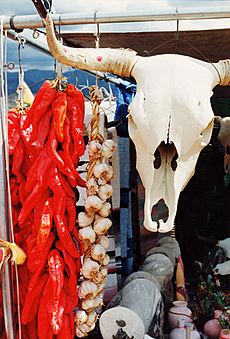
New Mexican culture is a special blend of Native American, Spanish, and American influences. People have lived here for thousands of years. Then, Spanish, Mexican, and American settlers arrived. This mix of groups is seen in New Mexico's people, place names, food, and language.
New Mexico is part of the "Old West" history. This includes cattle ranching, cowboys, and the Santa Fe Trail. The state's wide landscapes and many ghost towns keep this frontier image alive. Many Western movies are set or filmed in New Mexico.
New Mexico's Spanish and Mexican heritage is still very strong. It was an important part of New Spain.
New Mexico is a key center for Native American culture. About 200,000 residents are of Native American descent. There are 23 federally recognized tribal nations. Each has its own culture and history. The Navajo Nation is the largest reservation in the U.S. One-third of its members live in New Mexico. The Pueblo Indians live in 19 pueblos across the state. Many Native Americans have moved to cities like Gallup. The annual Gathering of Nations is the largest pow wow in the U.S.
Almost half of New Mexicans have Hispanic roots. Many are descendants of early Spanish settlers called Hispanos. Some Hispanos believe they have Jewish ancestry from early Spanish colonists. Many New Mexicans speak a unique Spanish dialect. It has old words and words from Native American languages.
New Mexico's Architecture
New Mexico's buildings show its long history. Early examples come from the Ancestral Puebloans. The Hispanos adapted the Pueblo architecture style. Later, the Territorial Style blended these styles. After New Mexico became a state, the Pueblo Revival and Territorial Revival styles became popular. These styles are still encouraged today.
Art, Books, and Media
The earliest artists in New Mexico were the Mimbres Indians. Their black and white pottery is very old but looks modern.
Santa Fe has a lively art community. It has many art museums, like the New Mexico Museum of Art. The city is full of art galleries. Every August, Santa Fe hosts the Santa Fe Indian Market. This is the oldest and largest Native American art show in the world. The Santa Fe Opera presents operas each summer.
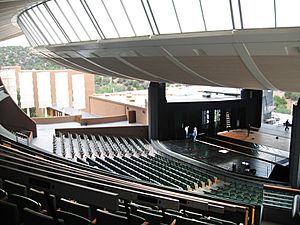
Albuquerque, the largest city, has many cultural events. It has the New Mexico Museum of Natural History and Science and the National Hispanic Cultural Center. The famous Albuquerque International Balloon Fiesta happens every year. The KiMo Theater in Albuquerque is a unique building from 1927. It shows live theater, concerts, and movies.
New Mexico keeps its Spanish heritage strong. Old Spanish traditions like flamenco are popular. The University of New Mexico has a program just for flamenco. The annual Festival Flamenco Internacional de Alburquerque is the largest flamenco event outside of Spain.
New Mexico has a special collection of books and stories. Famous authors like Rudolfo Anaya have written about the state. Folk heroes like Billy the Kid and Geronimo are from New Mexico. The state's history has also shaped its unique New Mexico music genre.
Many movies and TV shows are filmed in New Mexico. This is because of its varied landscapes and financial benefits. The TV series Breaking Bad was set and filmed in Albuquerque.
New Mexican Cuisine
New Mexico is famous for its unique food. It mixes Native American and Spanish-Mexican cooking styles. This food is different from other Latin American food in the U.S. It uses local spices, herbs, and vegetables. Red and green New Mexico chile peppers are very important.
Some unique New Mexican dishes include sopapillas (fried bread), breakfast burritos, and green chile stew. You can also find green chile burgers and posole (a corn dish). Many chefs are now serving traditional Native American food from food trucks.
Sports in New Mexico
New Mexico does not have major league professional sports teams. But the Albuquerque Isotopes are a minor league baseball team. They are linked to the MLB Colorado Rockies. The state also has other baseball teams and soccer teams.
College sports are very popular in New Mexico. The University of New Mexico Lobos and the New Mexico State Aggies have a big rivalry. It's called the "Rio Grande Rivalry" or the "Battle of I-25."
New Mexico is a major place for shooting sports. The NRA Whittington Center in Raton is a large shooting range.
Historical Places
New Mexico has many important historical and cultural sites. Forty-six places are listed on the U.S. National Register of Historic Places.
New Mexico has nine national monuments. This is the second-highest number in any state. These include El Morro National Monument and Gila Cliff Dwellings National Monument. They protect the state's ancient Native American heritage.
New Mexico is one of only eight states with more than one UNESCO World Heritage Site. It has three sites that are only within its borders.
Since 1970, New Mexico Magazine has a feature called One of Our 50 Is Missing. It shares funny stories about people who don't realize New Mexico is a U.S. state. To avoid confusion, New Mexico's license plates say "New Mexico USA." It is the only state that does this.
See also
 In Spanish: Nuevo México para niños
In Spanish: Nuevo México para niños





